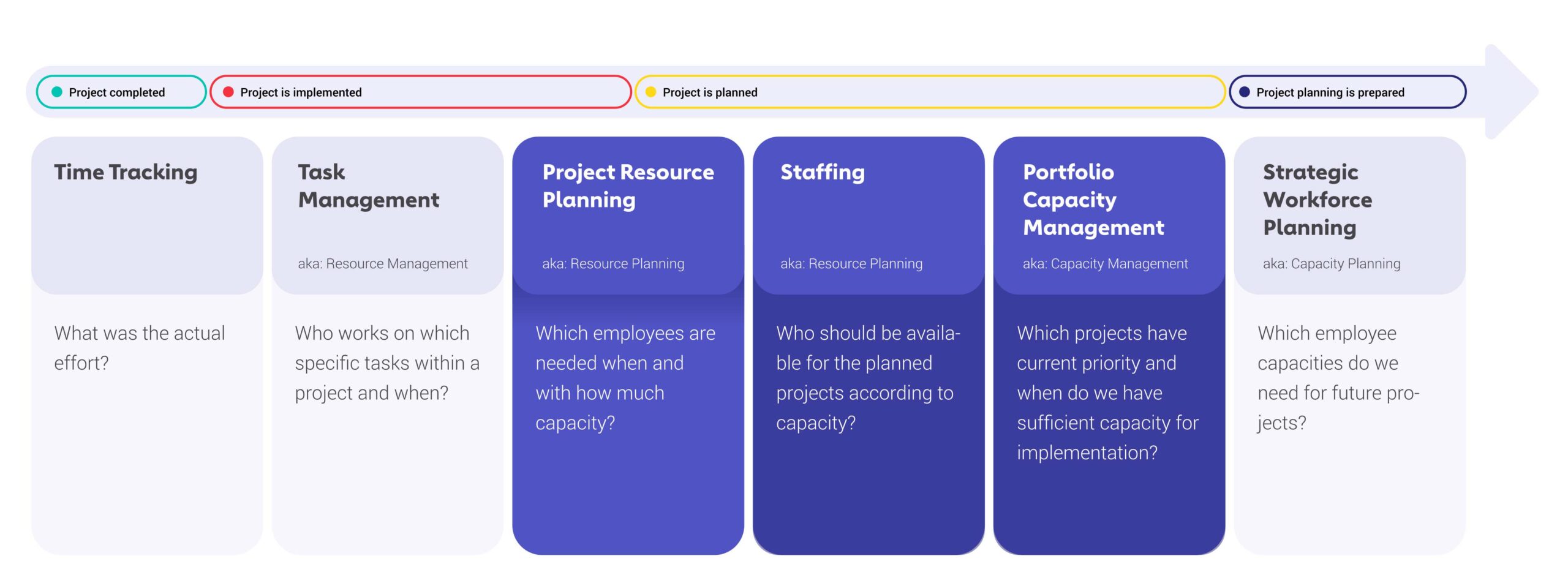“What exactly is resource planning?” – know that you’re not the only one asking this question. We hear it from team leads weighing employee burnout against successful delivery. From company management whose top priority is delivering reliable customer solutions. And from new project managers looking to learn more as they take on their new role.
Whether you belong to one of these groups or are simply curious, you’ve come to the right place. This article will help you answer the following questions:
What are resources?
What is resource planning?
What is the difference between resource planning and other similar terms?
What are the benefits of resource planning?
What is the difference between resource management and resource planning?
How does one manage resources?
How do other companies approach resource planning?
How can you best get started with resource planning?
What Are Resources?
The term “resources” refers to capital, assets, or tools needed for a specific purpose. This can include money for purchases, materials for production, information for decision-making, or even people’s skills and capacities for executing projects.
Why are people referred to as “resources”?
Find out more here.
Delays in production, decision-making, or projects inevitably arise when just one resource is missing from the puzzle. Individuals and their knowledge are resources of critical importance for company success and preventing such bottlenecks. While money, information, and materials can be stored and saved for later, poorly managed or unutilized time is lost forever. Resource planning is gaining importance for so many companies to make sure their time is used to the fullest.
But What Is Resource Planning?
Definition
Resource planning is the strategic allocation and scheduling of resources, especially for forecasting and budgeting. It involves planning, coordinating, and monitoring people, budgets, equipment, materials, and time.
Particularly in the world of projects, it is about aligning the supply of employee capacities with demand across different planning periods. Depending on the planning phase and project, different individuals with different concerns are involved, which can vary the level of detail in planning. Still, the goal of all these projects remains the timely completion of the right projects within the (capacity) budget without sacrificing quality.
Explained: Resources vs. Capacities & Planning vs. Management
Terminology in the world of resource planning can be confusing. For some, resources and capacities are the same, and management and planning are often used interchangeably. Others strictly separate these terms or differentiate only partially. Even in surveys within our company, there were different opinions.
But who is right? What wording should YOU use? After all, resources have capacities, and capacities only exist with resources. At the same time, planning is a part of management and vice versa. Phew.
Therefore, we have decided to name the various activities in the resource-capacity-planning-management cosmos based on the specific questions and the timing of implementation to shed a little light on the matter for ourselves and for you:
You’ve certainly noticed in our other posts that we throw around terms like resources, capacities, management, and planning pretty frequently. But what logic does our division follow? We use the term “resources” when it concerns specific employees and their skills and availability. “Capacity,” on the other hand, has less to do with individual employees and operates on a more general level. For us, “management” involves dealing with a project or issue in the present, while “planning” concerns itself with things potentially existing in the future. In short, resources and management deal with concrete, current matters; capacity and planning deal with more abstract, future-oriented concepts.
For many professionals, resource management serves as the umbrella term that encompasses all the activities mentioned above. However, most software providers consider resource management to be what we have labeled as task management in our graphic above (hence the “aka” annotation”).
For this article, we use “resource planning” as a collective term to focus on project resource planning, staffing, as well as portfolio capacity management and questions related to these topics.
A fundamental requirement for sensible resource planning is knowing which projects you want to undertake and when. How these priorities are determined will vary from company to company and will depend on which projects align most with internal objectives or what requirements customers might have. But it doesn’t end there!
Once priorities have been established, resource managers have to:
- Know which employees with which skills are available at any time, in case gaps arise
- Staff projects with specialists according to their priority
- Ensure that gaps are filled or that new priorities are set in case of absences
- Identify recurring bottlenecks and initiate recruitment of new personnel
- Exchange insight with project managers, employees, and upper management to decide on next steps
By now, you’ve probably realized how intertwined resource planning is with both project management and with timely, high-quality delivery. But how critical is it really?
Why Bother with Resource Planning?
The positive effects of efficient resource planning are wide-ranging and lead to unexpected benefits elsewhere. Knowing who is doing what when means you can shift employees to projects where their skills and/or capacity are needed once they’re available. If you can schedule more flexibly, pivot spontaneously when circumstances require, and achieve coordination across teams, tools, and working styles, then the sky is the limit. And this can be achieved more easily than you might think!
The advantages of resource planning include:
- Maximized utilization of employees’ skills and space for continuous personal development.
- Decreased constraints by other departments when planning.
- Relief for colleagues, increasing their satisfaction and improving morale.
- Transparency for everyone, helping management to make well-informed decisions.
- The ability to retrace your steps and explain your decisions.
- Composure and calm, due to predictable and realistic planning.
- Customer satisfaction, thanks to projects finished on time.
- Additional capacity for the projects you’ve been meaning to get to.
- Decisiveness in all circumstances, thanks to a comprehensive overview and clear head.
The Dangers of Ignoring Resource Planning
Here’s an example:
If there’s a gap in communication about available capacity, customers may be promised deadlines that cannot be met.
One potential result: The deadline is missed, perhaps more than once, and the customer cancels. To avoid this, employees are pushed to work overtime to meet the deadline. Sure, this is unavoidable at times; however, if this becomes business as usual, it harms employee well-being and reduces their work quality, leads to burnout, tempts them to seek new career opportunities, and could damage a company’s image.
You can read our appeal against this “firefighter mentality” here.
It’s plain to see: resource planning is worth the effort. Now that we’re on the same page, let’s see what resource planning looks like in the real world.
What Does It Mean to Plan Resources?
In the “but what is resource planning?” section, we outlined some of the responsibilities and benefits that come with resource planning. Here, we’d like to explore how to incorporate it into one’s medium-, short-, and long-term planning by way of a few examples. The company in our example is pursuing two objectives:
Objective 1: To complete as many projects as possible, with maximum quality, and on time.
Objective 2: To prioritize the well-being of your employees and retain their talent over the long-term.
Effective Medium-Term Planning
Let’s start with the medium-term perspective in resource planning. The availability of data for the medium-term and its influence on the upcoming weeks and months likely means it forms the central pillar of your planning.
Get a Lay of the Land
For a realistic plan, it is crucial that you, as resource manager, regularly communicate with all stakeholders. Only by receiving up-to-date information from employees, project management, and company management can you answer questions like:
- Which personnel with which skills are available to me?
- Which projects and day-to-day tasks are they currently working on, and how much capacity will be available taking into account planned vacations or other absences?
- Which projects are scheduled for implementation in the immediate future, and which of these projects have the highest priority?
Smaller companies tend to have an easier time gathering and storing this information centrally in spreadsheets. As a company grows larger and more complex, though, simple Excel tables become overly complicated, making other software solutions that centralize and update this information daily an essential time-saver.
A Challenge to Consider:
The following situation may be familiar: some teams are quick to adopt their own project management solutions, working in a highly agile manner, while others are not. These differing approaches to organization mean often teams plan in different ways, scattered across documents and software. Despite this, management still wants to know what is going on at any point in time and wants to be able to provide input.
Therefore, when getting your feet wet in the world of resource management, choose a solution that accommodates the needs of these teams yet centralizes the needed information right from the beginning. This will simplify your life significantly and facilitate success. For example, Meisterplan provides users with a centralized planning hub for decision-makers, while teams can continue working in their own tools thanks to our integration possibilities.
Without Further Ado — Let’s Get Started with Staffing and Project Resource Planning
Now that you have an overview of the needs of project planning as well as the capacity and skills that are available to you, we can really start organizing and planning resources.
Resource Planning? Resource Management?
While we tend to use the two terms interchangeably, there is some nuance. Resource management focuses on the allocation and utilization of resources during the execution of a project, involving some spontaneous decisions as things change in real time. Resource planning tends to be more forward-looking and focuses more heavily on the planning phase, ensuring that resources are optimally allocated based on availability and overall priorities.
Once your projects and priorities have been established, resource planning becomes second nature. After all relevant teams’ projects have been centrally stored and ranked in terms of priority, you simply need to assign resources from top to bottom until capacity has been reached. This process is called allocation.
Tip: Tools are a serious time-saver when it comes to resource capacity planning. With the right tools, you can see the current and future workload of your employees and how new projects or schedule changes might have an effect. In our opinion, a histogram is the easiest way to track resource capacity.
One of the chief benefits of resource planning is the early recognition of what is possible and what is not. After allocation, a histogram like the one above depicts long-term constraints or imminent bottlenecks that you can address right away with project or company management to find a solution. Resource managers and team leads are thus empowered to actively monitor the workload of their employees while ensuring that sufficient capacity is available for the most important projects.
Short-Term Planning: The Power of Pivoting
No matter how far in advance you plan, something always comes up in day-to-day operations. Whether it be a sudden bottleneck, an employee absence, new management directives, or a new regulatory environment.
The Brunt of It: Managing Bottlenecks
In such cases, it’s the job of resource management to keep things running the short-term. You have all the cards on the table (or in the tool of your choice) with which you can answer some important questions right off the bat:
- Do other employees have available capacity to compensate for the absence/bottleneck/etc.?
- Do some of the less urgent projects need to be postponed?
- • Are there employees who are waiting on deliveries from other departments, and who could be deployed elsewhere in the meantime?
As a resource manager with the right information, you can determine what is feasible and what is not. Though the final decision is usually made in collaboration with project managers, executives, and others, your knowledge is what holds everything together. Having this information readily available allows you to communicate transparently and (if needed) explain your decisions to the rest of the company.
Long-Term Planning
Long-term planning takes a different focus. The challenges of assigning employees and overcoming bottlenecks remain, but the focus lies now in gleaning insights from these repeated occurrences in short- and mid-term planning phases and taking strategic measures to reduce their frequency in the future.
To this end, key performance indicators (KPIs) such as resource utilization, resource availability, employee satisfaction, customer satisfaction, project completion times, and so on are typically monitored. These can then be displayed in a business intelligence tool to help make decisions. For example:
- KPIs point to capacity issues, so your focus should be on recruiting key resources that have caused bottlenecks in the past.
- KPIs point to an unmanageable volume of projects with the current resources, resulting in a reduction in the scope of project portfolios.
- KPIs indicate that a handful of teams have persistent, untapped capacity that can be utilized in the future to relieve bottlenecks or to help chip away on the next innovation project.
How are things on your end? Could you answer our example questions for medium-term, short-term, and long-term planning? Or did you relate to some of the problem areas while reading? Could your company also benefit from improved resource planning?
How Do Other Companies Manage Their Resources?
Like we said: You are not alone. Resource management can be complex, but with the right tools, it doesn’t have to be difficult. See below how one company uses Meisterplan to optimize its resource planning processes. “Learning by doing” is good, but learning from others can help save time.
Learn how Hays allocates over 300 resources to all sorts of IT projects without sacrificing flexibility or timeliness.
What’s the Best Way to Get Started?
Resources, resource planning, its benefits and various measures – it’s a lot to digest, and it can be hard to know how to get started. There are numerous ways to test the waters of resource planning when starting out. To help guide you, here are some tips that have helped us in the past.
- Get your colleagues on board: Present them with some of your ideas for implementing resource planning and try to generate interest within the company. Resource planning is all about teamwork after all!
- Find a good tool: Resist the urge to start too hastily with spreadsheets. Instead, choose a software solution that can accommodate the needs of your company from the beginning. This could be a more “static” software that has preset, role-based views depending on whether the user is a project or portfolio manager, or a more flexible package that accommodates agile, shifting teams.
- Start small: Begin by testing new tools and processes in just one department. This will make your efforts more manageable and give you time to experiment. If you are successful just once, others will naturally want to try it themselves.
We wish you all the best on your resource planning journey. Let us know about your experience with resource management or what other aspects of project portfolio management you have struggled with recently—we’re always happy to discuss!





